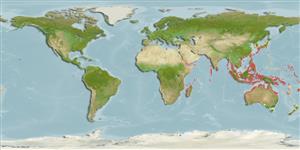>
Blenniiformes (Blennies) >
Blenniidae (Combtooth blennies) > Salariinae
Etymology: Istiblennius: Greek, istios = sail + Greek, blennios = mucus (Ref. 45335).
Eponymy: Jean-Jacques Dussumier (1792–1883) was a French merchant, collector, traveller and ship owner. [...] (Ref. 128868), visit book page.
More on author: Valenciennes.
Environment: milieu / climate zone / depth range / distribution range
Sinh thái học
Biển; Thuộc về nước lợ Cùng sống ở rạn san hô; Mức độ sâu 0 - 3 m (Ref. 86942). Tropical
Indo-West Pacific. East Africa to Fiji, north to Taiwan, south to the Norfolk Island.
Bộ gần gũi / Khối lượng (Trọng lượng) / Age
Maturity: Lm ? range ? - ? cm
Max length : 12.0 cm TL con đực/không giới tính; (Ref. 2334)
Các tia vây lưng cứng (tổng cộng) : 12 - 14; Các vây lưng mềm (tổng cộng) : 19 - 24; Tia cứng vây hậu môn: 2; Tia mềm vây hậu môn: 21 - 25. Dark spot distally between 1st 2 dorsal spines; (Ref. 4404). Males with about 6 dusky bands on body; females with bands that tend to form vertical rows of dusky spots; dusky spots on dorsal and caudal fins; anal fin uniformly dusky (Ref. 4404).
Facultative air-breathing (Ref. 126274); Euryhaline. Adults are often found in mangrove areas (Ref. 9962). They inhabit sheltered rocky shorelines and mangroves (Ref. 37816). Oviparous. Eggs are demersal and adhesive (Ref. 205), and are attached to the substrate via a filamentous, adhesive pad or pedestal (Ref. 94114). Larvae are planktonic, often found in shallow, coastal waters (Ref. 94114).
Life cycle and mating behavior
Chín muồi sinh dục | Sự tái sinh sản | Đẻ trứng | Các trứng | Sự sinh sản | Ấu trùng
Oviparous, distinct pairing (Ref. 205).
Springer, V.G. and J.T. Williams, 1994. The Indo-West Pacific blenniid fish genus Istiblennius reappraised: a revision of Istiblennius, Blenniella, and Paralticus, new genus. Smithson. Contrib. Zool. 565:1-193. (Ref. 9962)
IUCN Red List Status (Ref. 130435: Version 2024-1)
Threat to humans
Harmless
Human uses
Các nghề cá: không ích lợi (thú vị)
Các công cụ
Special reports
Download XML
Các nguồn internet
Estimates based on models
Preferred temperature (Ref.
123201): 23.1 - 29.3, mean 28.5 °C (based on 2688 cells).
Phylogenetic diversity index (Ref.
82804): PD
50 = 0.5001 [Uniqueness, from 0.5 = low to 2.0 = high].
Bayesian length-weight: a=0.00776 (0.00356 - 0.01695), b=3.00 (2.81 - 3.19), in cm total length, based on LWR estimates for this (Sub)family-body shape (Ref.
93245).
Mức dinh dưỡng (Ref.
69278): 2.0 ±0.00 se; based on food items.
Thích nghi nhanh (Ref.
120179): Chiêù cao, thời gian nhân đôi của chủng quần tối thiểu là dưới 15 tháng (Preliminary K or Fecundity.).
Fishing Vulnerability (Ref.
59153): Low vulnerability (10 of 100).
Nutrients (Ref.
124155): Calcium = 153 [66, 272] mg/100g; Iron = 0.793 [0.431, 1.467] mg/100g; Protein = 18.2 [17.0, 19.4] %; Omega3 = 0.0743 [, ] g/100g; Selenium = 16.7 [7.3, 39.3] μg/100g; VitaminA = 103 [26, 392] μg/100g; Zinc = 3.01 [1.92, 4.68] mg/100g (wet weight);
